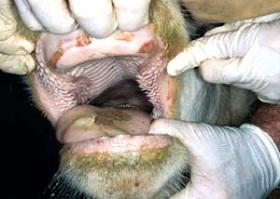River subbasins more depleted than
official figures show
09 April 2024
Published online 30 March 2012

Nearly 60,000 cattle have been infected with foot-and-mouth disease (FMD) in Egypt since mid-February, according to the General Organization for Veterinary Services (GOVS) in Giza, Egypt, and almost 10,000 animals have succumbed to the disease.
FMD causes high fevers in cloven-hoofed animals, followed by blisters inside the mouth and hooves. It is highly infectious and sometimes fatal, and airborne — transmitted over wide areas by wind. It rarely infects humans through ingestion of infected meat, since the picornavirus responsible for the disease is vulnerable to stomach acid.
Samples collected from farms in Egypt were sent to the FMD World Reference Laboratory in the UK, which confirmed that this strain of the virus, dubbed SAT2, is new to Egypt, normally found in wild animals in sub-Saharan Africa.
"It has not been reported in Egypt for at least 50 years," says Jef Hammond, head of the FMD World Reference Lab.
A report by the European Commission for the Control of FMD (EuFMD) of the UN's Food and Agriculture Organisation (FAO) states that the viral strain was first identified in the Animal Health Research Institute of Egypt (AHRI) on 18 February, 2012. The first SAT2 clinical case could have occurred even before February, according to the report.
Though the current strain of SAT2 is new, Hammond says that a vaccine exists to prevent SAT2. However, Egypt's own vaccine stocks do not protect against this serotype of the disease. The Veterinary Serum and Vaccines Research Institute in Egypt is currently working to mass produce the appropriate vaccine.
Sayed Zeidan, deputy director for production at the institute, says a vaccine for this particular strand of FMD has already been produced in his lab, and is under the final stages of testing. "We expect it to be ready for mass production within a few weeks. We will produce millions of dosages here, but they will be used for a long-term immunization campaign. This is a process that will take several months."
More preparation was needed to tackle outbreaks on such a scale.
GOVS has appealed to FAO to help supply the vaccine from other countries for immediate roll out. According to Markos Tibbo, FAO's Near East animal production and health officer, vaccine stocks are limited, and before importing any shipments in Egypt, the FAO needs to make sure they work against the strain in circulation and the cause of the current outbreak.
Ultimately, even if enough vaccines are available immediately, it will be of no use to the already infected cattle. It takes 2 weeks for the vaccine to protect the animal, during which the vaccinated livestock remain susceptible to infection.
The EuFMD/FAO report suggests short-term control efforts should focus on limiting spread of the disease by raising awareness among farmers and livestock keepers. They should not mix sick and healthy animals and halt the transport of animals.
To date, 25 of 28 governorates in Egypt are reporting cases of FMD cases, but the hardest hit areas are in the Nile Delta. It is possible that some of these cases are of a different variety of FMD, as the serotypes O and A have been endemic in Egypt for some time. GOVS has accused the government of failing to stop animal transfer across the country.
When Nature Middle East contacted the public relations office of the Egyptian Ministry of Agriculture, they issued an official statement saying "the government responded to the outbreak to the best of its abilities. Given the ease with which the disease travels, and that this is a new strain which Egypt's livestock has no immunity to, complete containment was not possible."
Tibbo says there's more the government could be doing, especially in communicating and involving farmers. "I think the government is trying hard but it is overwhelmed," he says. "More preparation was needed to tackle outbreaks on such a scale."
The FAO puts the risk of the disease spreading throughout North Africa at medium to high. Animal movement between North African countries is under little control at this time, raising the risk of FMD spreading. Smuggling, particularly between Libya and its neighbours, including Egypt, is rampant. Tighter border security will likely be key to stopping this outbreak from spreading to the rest of the region.
doi:10.1038/nmiddleeast.2012.44
Stay connected: